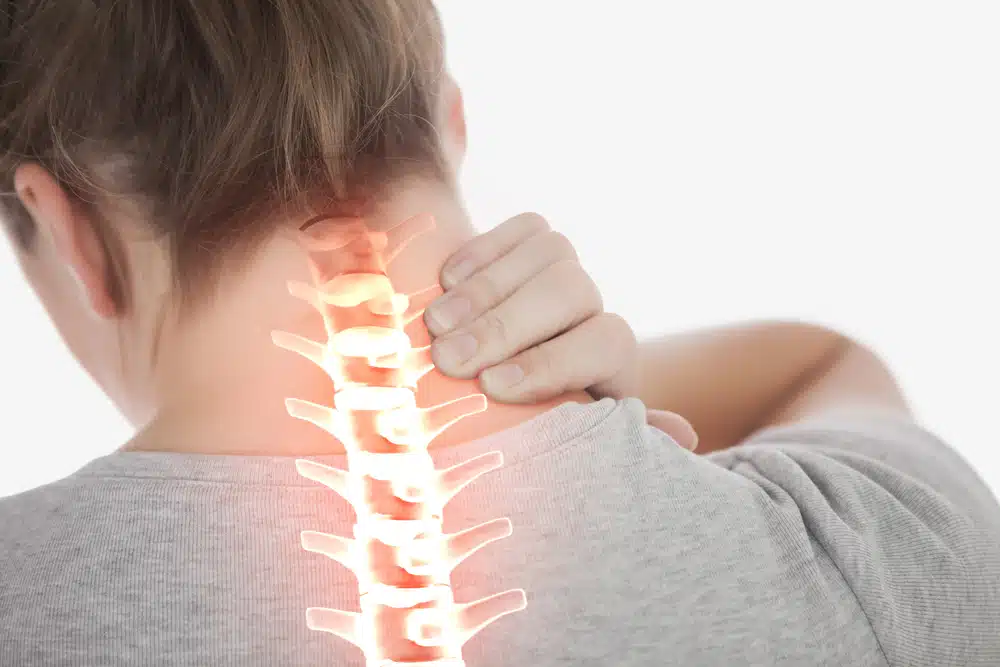Neck pain is one of the more common musculoskeletal disorders. Symptoms can vary in severity and duration depending on the underlying cause. Since there are many potential causes of neck pain, it is important to see a medical specialist for a proper diagnosis and treatment plan.
Causes of Neck Pain
Causes of neck pain are often grouped into broad categories such as:
- Traumatic: the result of an injury
- Degenerative: caused by wear and tear
- Other causes: which include tumors, infection, and autoimmune disorders
Traumatic
A traumatic cause of neck pain can be the result of an injury. Some injuries are minor and can resolve spontaneously while others may require medical attention and can have a prolonged recovery.
- Muscle strain – refers to injury to the muscle or its connecting tendons. This can be caused by sudden extension or flexion, such as in whiplash, or twisting awkwardly. These are typically minor injuries that can heal with rest, physical therapy and medications.
- Fracture – a fracture is a broken bone that can be the result of a fall or high impact injury like a car accident. In older people with osteoporosis (low bone density), fractures can occur with minimal trauma. Depending on what spinal structure is broken, such as the vertebrae, a fracture can be treated with bracing, however sometimes may require surgery.
Degenerative
Degenerative causes of neck pain refer to wear and tear of various spinal structures and can be a common cause of chronic neck pain. This is often age-related or due to repetitive injury.
- Canal Stenosis (narrowing) – the spinal cord and spinal nerves pass through canals within the spine. These can narrow due to bony overgrowth (osteophytes), thickening of ligaments (ligamentum flavum hypertrophy), or because of a herniated intervertebral disc.
- Herniated disc – the intervertebral discs can bulge, protrude, or rupture which can lead to pain and result in canal narrowing and compression of the spinal cord or spinal nerve roots
- Degenerative disc disease – refers to wear and tear of the intervertebral disc. The disc can be thought of as a gel filled sac (nucleus pulposus) with a fibrous outer layer (annulus fibrosus) that acts as a shock absorber. Overtime, the gel-like center can dry out and the outer layer may break down leading to pain.
- Spondylosis – is a general term that refers to age related wear and tear, or degeneration, of the spine
- Spondylolisthesis – refers to when one of the bones of the spine, called a vertebrae, slips forward or backwards from its normal position.
There are other causes of neck pain that are neither due to injury or degenerative changes in the spine.
- Tumor – An abnormal growth that may be benign or cancerous. Treatment may be surgery, radiation, chemotherapy, or a combination.
- Infection– An infection can affect the bones (osteomyelitis), the discs (discitis), or the space surrounding the spinal cord (epidural abscess).
- Autoimmune disorders – autoimmune disorders occur when your immune system misidentifies healthy cells as foreign and attacks them by mistake. Examples of these disorders are rheumatoid arthritis and ankylosing spondylitis.
An evaluation by a medical professional is highly recommended to ensure a proper diagnosis
Neck Pain Symptoms
Pain can be isolated to the neck or can cause additional symptoms if nerves or other structures are compressed or damaged. Symptoms commonly experienced include:
- Neck pain
- Arm pain
- Arm numbness
- Arm weakness
Diagnosis
A proper diagnosis should be made by a medical professional. Often the diagnosis can be made clinically, meaning based on a detailed interview and physical examination, however, sometimes more studies are needed based on the assessment or if symptoms do not improve after initial visits.
Imaging studies such as x-ray, CT scan, and MRI, are commonly used to help make a diagnosis. Each study visualizes different body parts and has its own strengths and weaknesses.
- X-ray – uses the passage of electromagnetic waves to create shadow-like images of bones and some organs. X-rays are quick and accessible but do a poor job evaluating soft tissues such as muscles and nerves. X-rays also result in a small amount of radiation.
- CT scan – also known as Computed Tomography, uses a series of x-rays along with computer processing to create detailed cross-sectional images. CT scans produce higher quality images that can also see organs and blood vessels. However, they are associated with more radiation exposure.
- MRI – which stands for Magnetic Resonance Imaging, uses a magnetic field and radio waves to create images of the body. MRI does a great job of visualizing tendons, ligaments, nerves, and intervertebral discs. Another benefit is that there is no radiation exposure. Unfortunately, MRI’s often are associated with longer wait times and higher cost.
Neck Pain Treatments
Treatments for neck pain should take into consideration the underlying cause. Typically a stepwise approach is taken, starting with the least invasive treatments (medications and physical therapy) to the most invasive (surgery).
- Medications – Medications can either be taken orally (by mouth) or applied topically (on the skin). Non-steroidal anti-inflammatory medications (NSAIDs), such as ibuprofen, are common first line treatments. More severe pain may be treated with opioids or muscle relaxants with extreme caution. Topical medications, which can be applied on the skin, include capsaicin cream or lidocaine patches.
- Physical Medicine & Rehabilitation – Some common treatments in this category include heat application, physical therapy, and spinal manipulation therapy (SMT).
- Invasive but non-surgical – These treatments include steroid injections and nerve ablation therapy.
- Surgical – Often considered a treatment of “last resort”, surgeries can either decompress pressure on the cord or nerves (such as a discectomy or laminectomy) or stabilize the spine (fusion).
A more comprehensive discussion of the various treatment options can be found in the “treatments” section.
